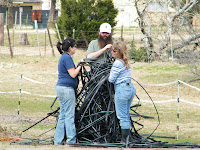Someone asked me if I'm writing a book about all of this. It would have to be a comedy, it's so unbelievable.
How else could you explain that a farmer, who is looking to retire, yet doesn't want to just sell out their land to the highest bidder, offers of which have been pretty promising (well, before all of the tariff nonsense and now, potentially war), but instead pulled together a lovely, mixed use, sustainable development of small, quality starter homes sharing the land with an existing working farm and a redevelopment of the commercial area into a vibrant, artisanal small/micro business hub - only to have some bitter, former colleagues and opponents from prior political times - sabotage the application needed to rezone to a different
use.
It's the stuff tragedies are made of.
Instead of the farmer retiring in peace, knowing her years of dedicated land stewardship will go on into perpetuity, she could be forced to sell to some stodgy commercial developer -
who will bulldoze down the century old farmhouse, that just needed some TLC to restore her to her original beauty, flatten over centuries old native trees and prairies, pour concrete culverts over creeks and streams and shorelines of the pond and erect tilt-wall concrete warehouses - where 18-wheelers full of freight containers can pull in and out at all and any hours of the day and night.
I mean what's the point? Who really wins here? The citizens of the community get more torn up streets. The neighbors adjacent to the once, serene, quiet and picturesque farm get noise, pollution and runoff.
oh, I guess the mean girls win b/c as they see it, the farmer loses - as she takes the money from the sale and moves away to a place not much unlike that of which she helped design for her own community.
Sure, she's sad that the land she loved was wasted, and that the town she embraced, served and was welcomed by gets ignored by their elected officials. But I can see a comic tragedy written out of the nonsense spewed in council meetings by people who have forgotten their jobs, and instead ridiculed, disrespected and accused people of impossible crimes and made up lies and BS scenarios that do not apply.
Can't you? If it weren't so sad - it could be funny.
This would not have happened if mature, responsible adults were in the room, but I digress. They WERE elected.
To be continued.....
Marie
Eat Your Food - Naturally!






















